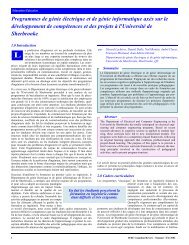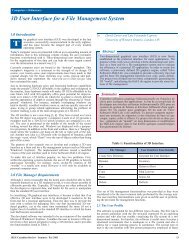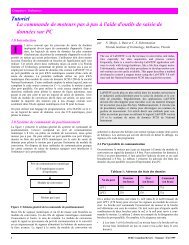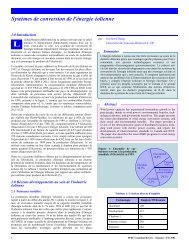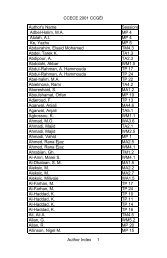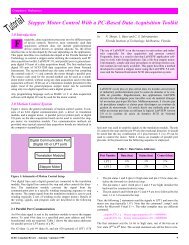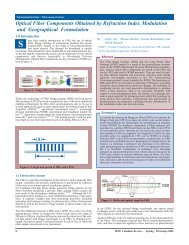CR51-Version 179 - IEEE
CR51-Version 179 - IEEE
CR51-Version 179 - IEEE
- No tags were found...
Create successful ePaper yourself
Turn your PDF publications into a flip-book with our unique Google optimized e-Paper software.
Telecommunications / TélécommunicationsAdaptive Routing Algorithms for All-Optical Networks1.0 IntroductionIn the last decades, many applications have been limited bythe bandwidth allowed by carrier networks. Nowadays, opticalnetworks based on wavelength division multiplexing(WDM) technology offer high-speed rate of data transfercombined with high reliability of the transmission channels. They conveydata on light wavelengths through optical fibers. Physically, tworequests cannot be transmitted simultaneously on the same wavelength,so it is mandatory to find the best way to allocate network resources inorder to support heavy traffic. Since optical routers have high switchingfrequencies and no waiting queues for data transmitted, it is critical tofind routing path for each request sent to these networks. In all-opticalnetworks, each routing path is called lightpath and used a unique wavelengthduring its lifetime. This constraint is the wavelength continuityconstraint (WCC).Optical routing algorithms that predetermine a unique path for any connectionrequested between two nodes, are called static, whereas thosethat respond to each request by taking into account the links’ state beforechoosing a path among a set of candidate paths are known as dynamic.In dynamic routing problem, for a set of requests between source-destinationpairs (s-d) coming dynamically to the nodes, we have to determinethe best routing paths among K candidate paths, by consideringlinks’ state, related costs and WCC. For the whole network, we must findthe best strategy to route payload data and satisfy the greatest number ofrequests. Processing time of requests and paths selection are primordialto avoid network congestion and, consequently, minimize blockingprobabilities of entering connections.This paper presents two new algorithms for dynamic optical routing.Section 2.0 states the mathematical model considered. Section 3.0describes the proposed algorithms. Section 4.0 presents and analyzesexperimental results. A conclusion is presented in Section 5.0.2.0 The Mathematical ModelLet us consider an optical network with N nodes and M links, one fiberper link and W wavelengths per fiber. The node and link locations arefixed and known. Each link has its own bandwidth, latency and cost.Connection requests arrive at each node following a Poisson process ofmean value λ. The following model is a classical optical routing modelwe present in order to describe our objective function.sdwLet Fijbe the request arrived at the node s for the node d and whichwill be transmitted on link (i,j) by using wavelength w. Note that i and jbelong to the set of nodes N.The total number of requested calls accepted through the network afterthe simulation, using the wavelength w between s and d, will be .In this problem, we wish to maximize the utilization rate of each link(i,j) in the network:ij∑sdwsdwijmax F(1)subject to following constraints:sdw• F ∈ { 0, 1}ij; which means either the lightpath established foreach request uses the wavelength w or not;sdw• ∑∑∑F≤ W ; which represents the capacityijs∈Nd∈N−{}s w∈Wconstraint on each link;sdwbyRolland Mêwanou, Samuel PierreÉcole Polytechnique de Montréal, QCAbstractThis paper proposes two new heuristic algorithms based on linkstatefor the dynamic routing problem in optical networks deprivedof wavelength converters. In those networks, dynamic routing consistsof transmitting data over unique wavelengths along dynamicallyestablished paths, while trying to minimize blocking probabilitiesof call requests. Both new algorithms were implementedand tested within ring topology and achieved satisfactory performancewhen compared to former algorithms such as FPLC andLLR algorithms.SommaireCet article propose deux algorithmes heuristiques basés sur le“link-state” pour le problème de routage dynamique dans lesréseaux optiques sans convertisseurs de longueurs d’ondes. Dansces réseaux, le routage dynamique consiste à transmettre des donnéessur des longueurs d’ondes uniques selon des chemins établisdynamiquement, tout en tentant de minimiser les probabilités deblocage des requêtes d’appel. Ces deux nouveaux algorithmes ontété implantés et testés sur une topologie en anneau et ont atteintune performance satisfaisante comparés aux algorithmes précédentstels que FPLC et LLR.IndexLink-state routing, optical routing, routing and wavelength assignment(RWA), wavelength division multiplexing (WDM).•sdw∑F ij− ∑Fiksdwjk⎧−⎪= ⎨ ⎪⎩ 03.0 The Two Heuristic Algorithms Proposedsdwsdwif s = jif d = jotherwisewhich is the WCC for each lightpath chosen.The problem is solved by choosing thesdwFijIn order to simulate our algorithms, K candidate paths must be precomputedfor each source-destination pair and we modify Yen’s Algorithm[4], [6] to achieve suitable results over shorter time. Dijkstra’s Algorithmis used to obtain the shortest path between two nodes.Our two algorithms used the criteria of former algorithms such as LLR[5] and FPLC [1] to define new strategies. The first one, called EstimatedCongestion Routing (ECR), is based on an estimate function ofthe congestion over links. The second algorithm, Hybrid Fixed-PathsLeast Congested (HFPLC-k), is more rigorous with an exhaustive analysisof the resources available on the network.;, depending on links’state. Then, our dynamic model uses this method applied step-by-step.By trying to resolve our objective function, we also help minimizing thenumber of blocked requests.As formulated, this problem has been demonstrated NP-hard and is notsolvable with standard mathematical approaches.<strong>IEEE</strong> Canadian Review — Fall / Automne 2005 17


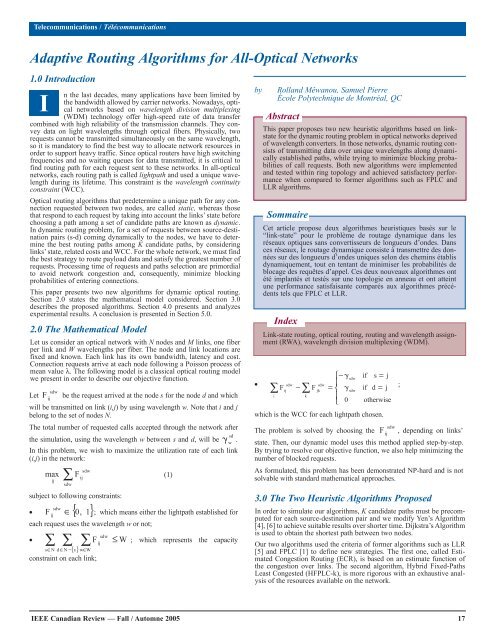
![Download Presentation [1.9MB PDF] - IEEE](https://img.yumpu.com/51364167/1/190x146/download-presentation-19mb-pdf-ieee.jpg?quality=85)

![Download Presentation [950KB PDF] - IEEE](https://img.yumpu.com/50598566/1/190x146/download-presentation-950kb-pdf-ieee.jpg?quality=85)

